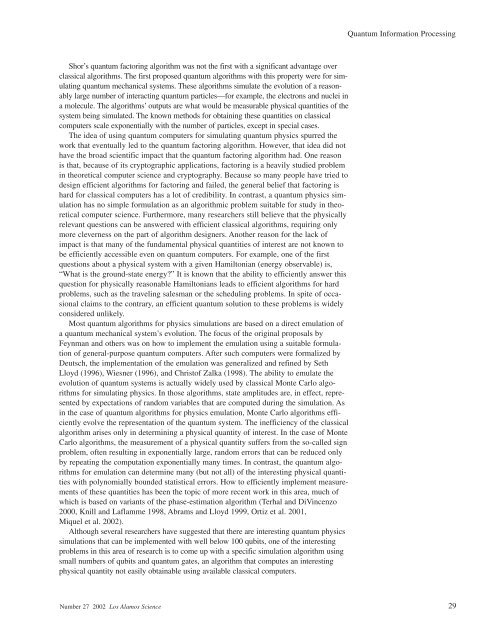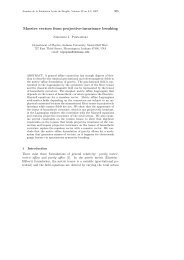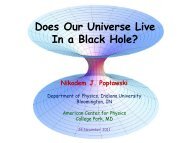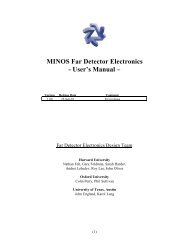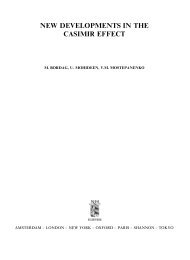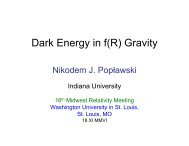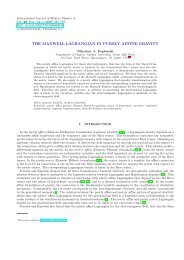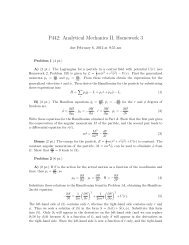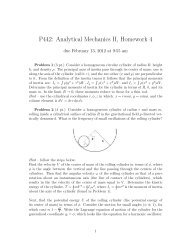Quantum Information Processing
Quantum Information Processing
Quantum Information Processing
You also want an ePaper? Increase the reach of your titles
YUMPU automatically turns print PDFs into web optimized ePapers that Google loves.
Shor’s quantum factoring algorithm was not the first with a significant advantage over<br />
classical algorithms. The first proposed quantum algorithms with this property were for simulating<br />
quantum mechanical systems. These algorithms simulate the evolution of a reasonably<br />
large number of interacting quantum particles—for example, the electrons and nuclei in<br />
a molecule. The algorithms’ outputs are what would be measurable physical quantities of the<br />
system being simulated. The known methods for obtaining these quantities on classical<br />
computers scale exponentially with the number of particles, except in special cases.<br />
The idea of using quantum computers for simulating quantum physics spurred the<br />
work that eventually led to the quantum factoring algorithm. However, that idea did not<br />
have the broad scientific impact that the quantum factoring algorithm had. One reason<br />
is that, because of its cryptographic applications, factoring is a heavily studied problem<br />
in theoretical computer science and cryptography. Because so many people have tried to<br />
design efficient algorithms for factoring and failed, the general belief that factoring is<br />
hard for classical computers has a lot of credibility. In contrast, a quantum physics simulation<br />
has no simple formulation as an algorithmic problem suitable for study in theoretical<br />
computer science. Furthermore, many researchers still believe that the physically<br />
relevant questions can be answered with efficient classical algorithms, requiring only<br />
more cleverness on the part of algorithm designers. Another reason for the lack of<br />
impact is that many of the fundamental physical quantities of interest are not known to<br />
be efficiently accessible even on quantum computers. For example, one of the first<br />
questions about a physical system with a given Hamiltonian (energy observable) is,<br />
“What is the ground-state energy?” It is known that the ability to efficiently answer this<br />
question for physically reasonable Hamiltonians leads to efficient algorithms for hard<br />
problems, such as the traveling salesman or the scheduling problems. In spite of occasional<br />
claims to the contrary, an efficient quantum solution to these problems is widely<br />
considered unlikely.<br />
Most quantum algorithms for physics simulations are based on a direct emulation of<br />
a quantum mechanical system’s evolution. The focus of the original proposals by<br />
Feynman and others was on how to implement the emulation using a suitable formulation<br />
of general-purpose quantum computers. After such computers were formalized by<br />
Deutsch, the implementation of the emulation was generalized and refined by Seth<br />
Lloyd (1996), Wiesner (1996), and Christof Zalka (1998). The ability to emulate the<br />
evolution of quantum systems is actually widely used by classical Monte Carlo algorithms<br />
for simulating physics. In those algorithms, state amplitudes are, in effect, represented<br />
by expectations of random variables that are computed during the simulation. As<br />
in the case of quantum algorithms for physics emulation, Monte Carlo algorithms efficiently<br />
evolve the representation of the quantum system. The inefficiency of the classical<br />
algorithm arises only in determining a physical quantity of interest. In the case of Monte<br />
Carlo algorithms, the measurement of a physical quantity suffers from the so-called sign<br />
problem, often resulting in exponentially large, random errors that can be reduced only<br />
by repeating the computation exponentially many times. In contrast, the quantum algorithms<br />
for emulation can determine many (but not all) of the interesting physical quantities<br />
with polynomially bounded statistical errors. How to efficiently implement measurements<br />
of these quantities has been the topic of more recent work in this area, much of<br />
which is based on variants of the phase-estimation algorithm (Terhal and DiVincenzo<br />
2000, Knill and Laflamme 1998, Abrams and Lloyd 1999, Ortiz et al. 2001,<br />
Miquel et al. 2002).<br />
Although several researchers have suggested that there are interesting quantum physics<br />
simulations that can be implemented with well below 100 qubits, one of the interesting<br />
problems in this area of research is to come up with a specific simulation algorithm using<br />
small numbers of qubits and quantum gates, an algorithm that computes an interesting<br />
physical quantity not easily obtainable using available classical computers.<br />
<strong>Quantum</strong> <strong>Information</strong> <strong>Processing</strong><br />
Number 27 2002 Los Alamos Science 29


